Celery sticks are pickled in soy and fish sauce based vinegar. Fish sauce gives umami to the pickled celery and almost eliminates its strong flavour. Pickled Celery in Fish Sauce is not a traditional Japanese pickled dish, but I like it and I hope you will like it, too.
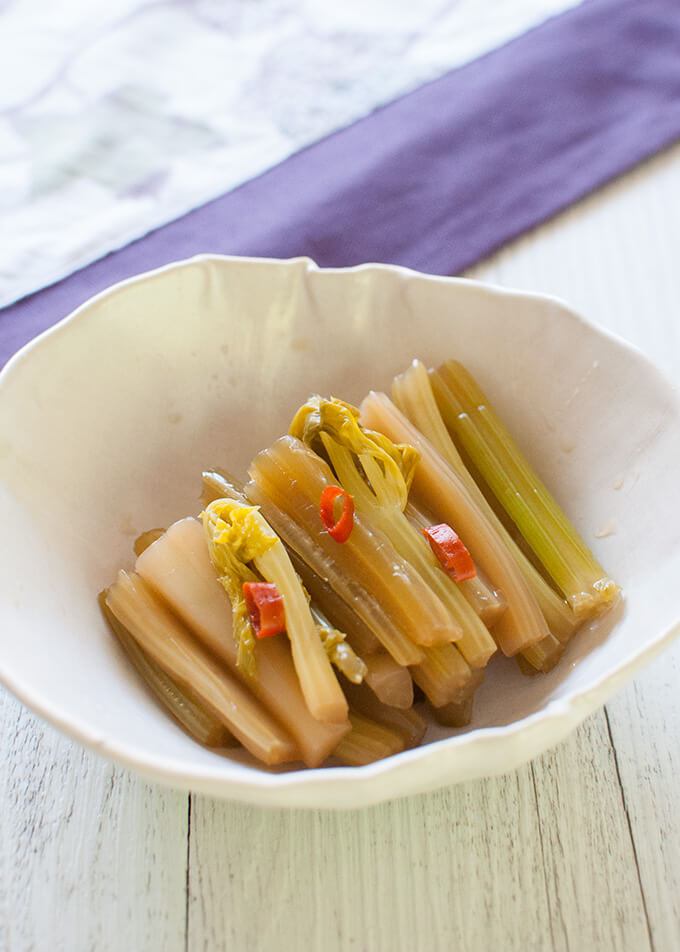
This is a very new recipe I made only about 3 years ago. When I was searching the net for a recipe that could use a large amount of celery, I found this interesting recipe on a Japanese recipe site.
I thought it was quite unique because not many recipes in Japan use fish sauce. Fish sauce is very salty, but I like the flavour as it has umami in it. So, I made pickles using this recipe. It was tasty but I wanted to adjust the ingredients to my liking.
Just like my other pickled celery dish Simple Pickled Celery, Pickled Celery in Fish Sauce is a very simple dish to make. Mix the pickling liquid ingredients, cut and blanch the celery, add the celery to the liquid and store in the fridge for 1-2 days. It keeps a few weeks in the fridge.
The pickling liquid is a mixture of soy sauce, fish sauce, rice wine vinegar, lemon juice and cooled boiled water. The original recipe added sugar and garlic, but I think that garlic can be omited as the flavour from the fish sauce is so great. I also didn’t want this to be sweet as I don’t have a sweet tooth. And I reduced the amount of fish sauce as I thought the flavour was a bit too salty.
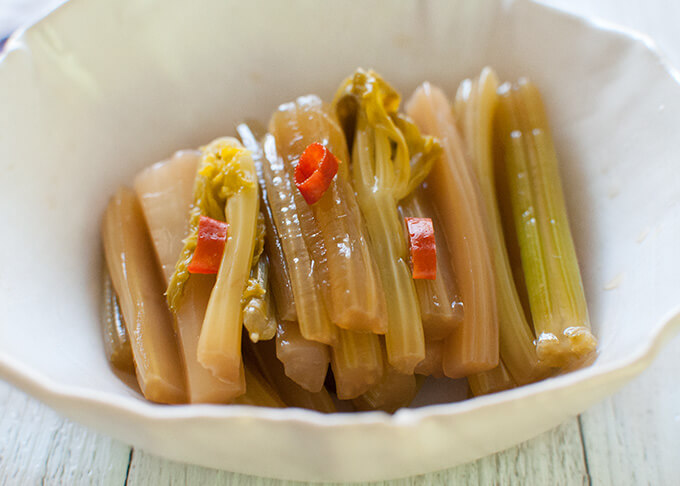
I mentioned to you a few weeks ago that Nagi left a big bunch of celery with me just before she left for Salt Lake City to give a presentation at the Everything Food Conference. There was no way that I could consume the entire bunch of fresh celery quickly.
So, I made three kinds of celery dishes that used quite a lot of celery – Pickled Celery in Fish Sauce (today’s recipe), KinpiraCelery and Chicken, and Celery and Carrot Stir Fry. The stir fry dish had to be eaten when cooked but the other two dishes could keep many days in the fridge. Kimpira Celery and the stir fry dish will be posted sometime later so that you won’t be bombarded with celery dishes week after week.
Tough Strings of Celery
Celery has tough strings that run vertically along the stems. I used to remove them before I started cooking because they could be really tough and stringy. They sometimes become nuisance as they stick between your teeth.
Removing these strings before using celery is a common practice in Japan and many recipes start with removing the tough strings whenever celery is included in the ingredients. But in Australia, people do not seem to pay much attention to the removal of the strings, even if Aussie celery is tougher than Japanese celery.
During 30+ years of my living in Australia, I adapted to the Aussie ways where convenient and handling of celery strings was one of them. I don’t always remove the strings, especially when celery sticks are cut into small pieces or slices in such a way that the length of the vertical string is minimal.
But like today’s dish where the celery sticks are cut into 5cm (2”) long pieces, I remove the strings otherwise you could end up chewing 5cm (2”) long tough strings. Removing the strings is quite easy. There are many different methods, but I remove them one by one using a knife.
- Place a small knife at the end of the celery stick where the edge of a tough string is.
- Make a small incision diagonally outward holding the surface of the tough string with the thumb so that the end of tough string is placed between the knife and the thumb.
- Move the knife along the celery stick while holding the end of the string. The string will come off easily to the other end of the stick.
Removal of the tough strings should be done before cutting/slicing the celery sticks.
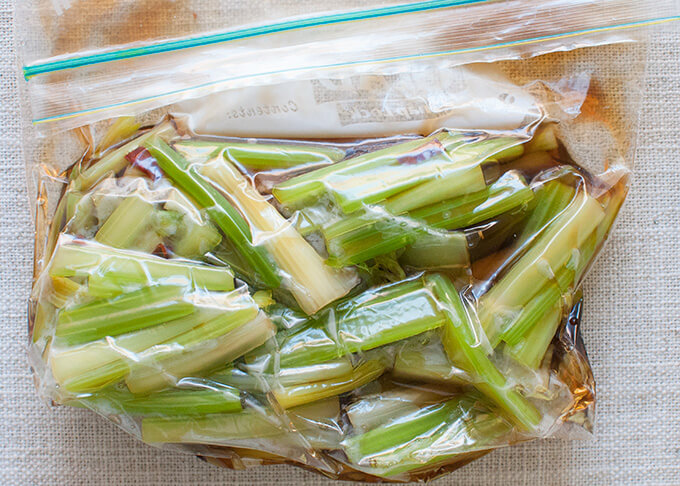
It would be ideal to cut most of the 5cm (2”) sticks into about 1cm (⅜”) thick matchsticks but due to the shape of the celery stems, you might find that it is not always easy. Even if the thickness is different, that’s OK – see the above photo of my celery sticks. Also, don’t discard the tip of the celery stems including the tiny branches with some leaves.
After marinating the celery sticks, you will notice that the colour of the celery sticks varies. This is normal, and I think that the different colour tone makes this dish more interesting. The photo below is the celery pickled for 2 days.
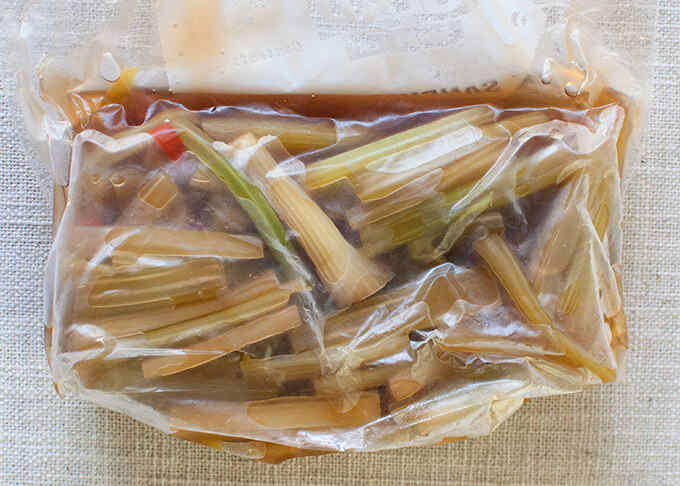
The tip of the celery stick that did not require a vertical cut to make it thinner, comes out greener than the others. Those sticks that have more vertical cuts come out darkest, except the sticks from the white part of the celery near the root.
This is an excellent little dish that can be served in a typical Japanese meal with rice. Even if a non-Japanese ingredient is used in the pickling liquid, it surprisingly goes very well with rice. I also served Pickled Celery in Fish Sauce on a cheese and cured meat plate in place of gherkins (cornichons) or pickled olives.
The original recipe says that you can eat it after just 1 hour of marinating but I find that the flavour of fresh celery is still too strong just after 1 hour and I recommend marinating it overnight.
Yumiko![]()
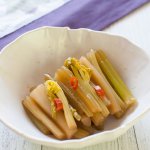
Celery sticks are pickled in soy and fish sauce based vinegar. The fish sauce gives umami to the pickled celery and almost eliminates its strong flavour. Pickled Celery in Fish Sauce is not a traditional Japanese pickled dish, but it goes well with rice.
- 300g (0.7lb) celery sticks
- 2 dried red chillies , finely chopped
- 2 tbsp fish sauce
- 1 tbsp soy sauce
- 1 tbsp rice wine vinegar (note 1)
- 1 tbsp lemon juice
- 2 tbsp cold boiled water
-
Add all the Pickling Sauce ingredients to a zip lock bag (note 2) large enough to contain all the celery sticks.
-
Remove the tough strings of celery sticks that run vertically on the surface of the skin (note 2). Cut the celery into 5cm (2”) long pieces, then cut vertically into about 1cm (⅜”) wide sticks. If the tip of the celery sticks or branches are very thin, no need to cut vertically.
-
Boil water in a saucepan and add the celery sticks. Leave the celery in the saucepan for 30 seconds or so, then drain using a sieve.
-
While the celery sticks are still hot (note 3), transfer them to the zip lock bag with the sauce. Also add the chilli pieces to the bag.
-
Massage the bag gently ensuring that the sauce covers all the celery sticks. Seal the zip after letting the air out as much as possible (note 4).
-
Store the bag in the fridge for minimum overnight to 2 nights.
1. You can substitute with apple cider vinegar.
2. To remove the tough strings:
i) Place a small knife at the end of the celery stick where the edge of a tough string is.
ii) Make a small incision diagonally outward holding the surface of the string with the thumb so that the end of the string is placed between the knife and the thumb.
iii) Move the knife along the celery stick while holding the end of the string. The string will come off easily to the other end of the stick.
3. If your zip lock bag cannot take hot food, use a bowl to mix the sauce, the celery sticks and chillies. When the pickled celery sticks cool down, transfer to the bag.
4. Without using a vacuum sealing machine, the following is the best way to make a vacuum sealed bag of pickled celery:
i) Fill water in the sink or a large deep bowl/bucket to the depth of about 15cm (½ft).
ii) Seal the zip allowing a small opening at one corner.
iii) Hold the zip part of the zip lock bag and gently lower the bag into the water.
iv) Massage the bag under water to let the air move up while lowering the zip lock bag to the zip line. This will reduce the air pockets in the bag.
v) When most of the air inside the bag is removed, close the zip to seal.
vi) Take the bag out of the water and you will see the bag is nearly vacuum sealed with the pickling sauce all over the celery sticks.
5. The recipe was developed based on this Japanese recipe.
I loved these!
I also had a surplus of celery and was looking for something to go with a Japanese meal. These were really tasty and unique. Thanks Yumiko!
Hi Erin, that’s great and good use of excess celery.
Yumiko! Love this recipe and your impeccable website! It is perfect as it stands, however, I don’t mind saying that the addition of mirin and lemongrass are a nice diversion. I agree that several potent ingredients-squared off-can be ameliorative and then, sublime. The Italian grimmolata and the Indian Garam Masala are good examples of flavor counterpoints to which I can now add celery and fish sauce.
Hi Gabriel, I can imagine how well these additions can go with the marinade. Thanks for letting us know!
I normally don’t eat celery because of the strong taste, but I want to try this recipe out. I’ve been reading how pickled vegetables are good for you so I’d like to incorporate them into my diet. Could I do this recipe with cucumbers?
Hi Janine, I have not tried with cucumbers but I cannot see why you can’t. If your cucumber has a lot of watery seeds in the centre (eg. large fat cucumber with thick skin), I’d suggest that you remove it because it will make the marinating liquid too thin. Please let me know how it goes.
This looks very interesting, I’m always looking for new and different ideas.! I have all the ingredients so I think I will give it a try. Once I have tried it I will be back to give it a rating. Thanks for a great email 🙂
Hi Jacquie, please do let me know what you think of it.